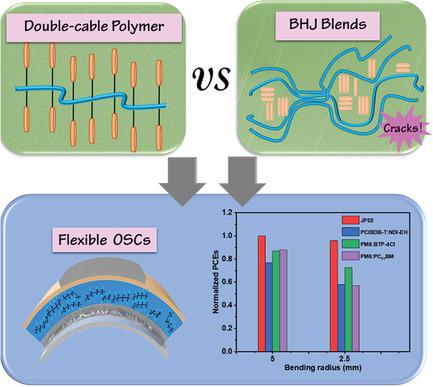当前位置:
X-MOL 学术
›
Small Methods
›
论文详情
Our official English website, www.x-mol.net, welcomes your
feedback! (Note: you will need to create a separate account there.)
Mechanical Robust Flexible Single-Component Organic Solar Cells
Small Methods ( IF 10.7 ) Pub Date : 2021-08-06 , DOI: 10.1002/smtd.202100481 Chengcheng Xie 1 , Xudong Jiang 1, 2 , Qinglian Zhu 3 , Dan Wang 1 , Chengyi Xiao 1 , Chunhui Liu 1 , Wei Ma 3 , Qiaomei Chen 1 , Weiwei Li 1
Small Methods ( IF 10.7 ) Pub Date : 2021-08-06 , DOI: 10.1002/smtd.202100481 Chengcheng Xie 1 , Xudong Jiang 1, 2 , Qinglian Zhu 3 , Dan Wang 1 , Chengyi Xiao 1 , Chunhui Liu 1 , Wei Ma 3 , Qiaomei Chen 1 , Weiwei Li 1
Affiliation

|
Owing to the advantages of being lightweight and compatible with surfaces with different deformations, flexible organic solar cells (OSCs) have broad scopes of applications, including wearable electronics and portable devices. Most flexible OSCs focus on the two-component bulk-heterojunction (BHJ) photo-active layers, but they usually suffer from degradation problems both in efficiency and mechanical durability derived from the limited phase stability under mechanical and thermal stress. Whereas, single-component organic solar cells (SCOSCs) based on the double-cable conjugated polymer are supposed to possess excellent mechanical robustness and long-term stability. Here, the first flexible SCOSCs based on a double-cable polymer are fabricated on a transparent silver nanowires (AgNWs) electrode on a plastic foil. Impressively, the obtained flexible SCOSCs exhibited a power conversion efficiency (PCE) of 7.21%. The flexible SCOSCs are further demonstrated to possess superior mechanical robustness (>95% retention after 1000 bending cycles) and storage stability (>97% retention after 430 h in nitrogen atmosphere) compared to several BHJ-type flexible OSCs. The pseudo-free-standing tensile test and morphology investigation are conducted to reveal the distinction in mechanical durability of the single-component polymer film and the BHJ-type films. Besides, ultraflexible SCOSCs are also fabricated, indicating the application prospect and superiority in flexible devices and wearable electronic products.
中文翻译:

机械坚固的柔性单组分有机太阳能电池
由于重量轻且与不同变形的表面兼容,柔性有机太阳能电池(OSC)具有广泛的应用范围,包括可穿戴电子设备和便携式设备。大多数柔性 OSC 专注于双组分体异质结 (BHJ) 光活性层,但由于机械和热应力下的有限相稳定性,它们通常会在效率和机械耐久性方面存在退化问题。然而,基于双电缆共轭聚合物的单组分有机太阳能电池 (SCOSC) 应该具有出色的机械强度和长期稳定性。在这里,第一个基于双电缆聚合物的柔性 SCOSCs 是在塑料箔上的透明银纳米线 (AgNWs) 电极上制造的。令人印象深刻的是,获得的柔性 SCOSC 的功率转换效率 (PCE) 为 7.21%。与几种 BHJ 型柔性 OSC 相比,柔性 SCOSC 被进一步证明具有优异的机械强度(1000 次弯曲循环后保持率 >95%)和储存稳定性(在氮气气氛中 430 小时后保持率 >97%)。进行伪独立拉伸试验和形态研究以揭示单组分聚合物薄膜和 BHJ 型薄膜在机械耐久性方面的区别。此外,还制备了超柔性SCOSCs,显示了在柔性设备和可穿戴电子产品中的应用前景和优越性。与几种 BHJ 型柔性 OSC 相比,1000 次弯曲循环后保持率 95%)和储存稳定性(在氮气氛中 430 小时后保持率 >97%)。进行伪独立拉伸试验和形态研究以揭示单组分聚合物薄膜和 BHJ 型薄膜在机械耐久性方面的区别。此外,还制备了超柔性SCOSCs,显示了在柔性设备和可穿戴电子产品中的应用前景和优越性。与几种 BHJ 型柔性 OSC 相比,1000 次弯曲循环后保持率 95%)和储存稳定性(在氮气氛中 430 小时后保持率 >97%)。进行伪独立拉伸试验和形态研究以揭示单组分聚合物薄膜和 BHJ 型薄膜在机械耐久性方面的区别。此外,还制备了超柔性SCOSCs,显示了在柔性设备和可穿戴电子产品中的应用前景和优越性。
更新日期:2021-09-14
中文翻译:

机械坚固的柔性单组分有机太阳能电池
由于重量轻且与不同变形的表面兼容,柔性有机太阳能电池(OSC)具有广泛的应用范围,包括可穿戴电子设备和便携式设备。大多数柔性 OSC 专注于双组分体异质结 (BHJ) 光活性层,但由于机械和热应力下的有限相稳定性,它们通常会在效率和机械耐久性方面存在退化问题。然而,基于双电缆共轭聚合物的单组分有机太阳能电池 (SCOSC) 应该具有出色的机械强度和长期稳定性。在这里,第一个基于双电缆聚合物的柔性 SCOSCs 是在塑料箔上的透明银纳米线 (AgNWs) 电极上制造的。令人印象深刻的是,获得的柔性 SCOSC 的功率转换效率 (PCE) 为 7.21%。与几种 BHJ 型柔性 OSC 相比,柔性 SCOSC 被进一步证明具有优异的机械强度(1000 次弯曲循环后保持率 >95%)和储存稳定性(在氮气气氛中 430 小时后保持率 >97%)。进行伪独立拉伸试验和形态研究以揭示单组分聚合物薄膜和 BHJ 型薄膜在机械耐久性方面的区别。此外,还制备了超柔性SCOSCs,显示了在柔性设备和可穿戴电子产品中的应用前景和优越性。与几种 BHJ 型柔性 OSC 相比,1000 次弯曲循环后保持率 95%)和储存稳定性(在氮气氛中 430 小时后保持率 >97%)。进行伪独立拉伸试验和形态研究以揭示单组分聚合物薄膜和 BHJ 型薄膜在机械耐久性方面的区别。此外,还制备了超柔性SCOSCs,显示了在柔性设备和可穿戴电子产品中的应用前景和优越性。与几种 BHJ 型柔性 OSC 相比,1000 次弯曲循环后保持率 95%)和储存稳定性(在氮气氛中 430 小时后保持率 >97%)。进行伪独立拉伸试验和形态研究以揭示单组分聚合物薄膜和 BHJ 型薄膜在机械耐久性方面的区别。此外,还制备了超柔性SCOSCs,显示了在柔性设备和可穿戴电子产品中的应用前景和优越性。











































 京公网安备 11010802027423号
京公网安备 11010802027423号